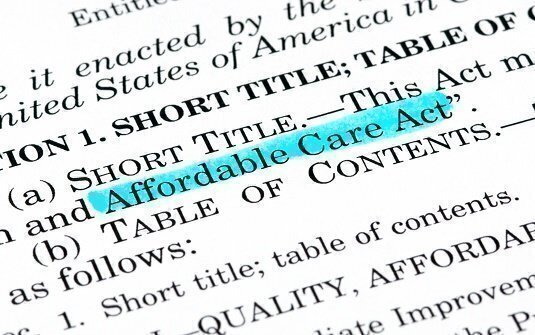Tentatively accepting the Trump Administration’s view that Congress has not put up any money to cover federal subsidies for health insurance companies, a federal judge in California on Wednesday refused – at least for now – to order a resumption of those payments.
 This year, those subsidies were running at about $600 million a month before President Trump ordered earlier this month that they be stopped.
This year, those subsidies were running at about $600 million a month before President Trump ordered earlier this month that they be stopped.
U.S. District Judge Vince Chhabria of San Francisco stressed that he has had little chance to study the dispute closely so far, and might change his mind after full development of this Affordable Care Act lawsuit filed by 18 states and the local government in Washington, D.C.
As the ruling stands right now, though, the Administration could claim two significant even if only temporary victories: first, the judge specifically found that the government has the better legal argument at least at this early stage of the case, and second – more generally – the judge’s ruling broke a string of temporary losses that the Administration has been losing for its policies in the federal courts.
However, Judge Chhabria by implication disputed President Trump’s repeated claim that the Affordable Care Act is collapsing on its own. The judge found that many of the states – 38, he said – had found ways, working with health insurers, to help the insurance marketplaces (“exchanges”) continue to function even without the insurers’ subsidies.
Moreover, the judge said, those work-arounds may well lower the cost of insurance sold on those marketplaces to lower-income people and may actually increase the availability of health coverage for people in the lower income brackets. The positive benefits that he saw were based upon the highly technical way that the policies sold on those exchanged are priced, and how the premiums as well as costs of health care are reduced by ACA subsidy provisions.
Judge Chhabria directly disputed the claims of the challenging state and local governments that the temporary loss of subsidies for the insurers will force premiums to rise sharply and cause many insurers to simply back out of the exchanges altogether, leaving many without any coverage options.
Based on the positive benefits he perceived in the work-arounds, the judge bluntly suggested that state officials “should stop yelling about higher premiums” and about the possible confusion among consumers about the impact of the cutoff of the subsidies for insurers.
He wrote: “With open enrollment just days away [beginning November 1], perhaps the states should focus instead on communicating the message that they have devised a response to the…payment termination that will prevent harm to the large majority of people while in fact allowing millions of lower-income people to get a better deal on health insurance in 2018.”
The judge did find that the cutoff of payments that would have been made this month and in the next few months will cause some harm to the challenging states’ residents and some added costs to the states, but he said that the case will be progressing forward in his court, with a final decision perhaps coming by early in the next year.
The only issue before him at this early point in the lawsuit, he noted, was whether to issue a temporary order requiring the payment of the subsidies for the next few months. What might happen in 2019 and beyond, he said, was “not particularly relevant at the moment” because the states might win the case when it is finished.
The key constitutional question in the lawsuit is whether Congress, in creating a system of subsidies for health insurance companies to offset their reduction of costs to buyers of their insurance on the exchanges, had actually approved the spending to cover the monthly payments. The Trump Administration has concluded that Congress did not do so, but the challenging state and local governments have argued that Congress did put up the money in order to make the ACA system work financially.
After recounting the opposing positions, Judge Chhabria said the Administration had the better view, at least for purposes of heading off an order to resume the subsidy payments. He went through, in detail, the two sides’ interpretations of how the ACA exchanges were to work, how the ACA’s complicated financial structure was set up, and how Congress does – or does not – put up the funding to cover such a program. That examination brought him down on the side, for the time being, of the Administration.
The Constitution expressly provides that no federal money may be paid out of the Treasury unless Congress has passed a law to approve the specific outlays. The ACA is somewhat opaque in what it says on the funding of the insurers’ subsidies.
By contrast, the ACA language is clear – and no one disputes it – in saying explicitly that Congress had provided the funds to cover another ACA subsidy: the tax credits that lower-income consumers receive to help them offset their monthly insurance premiums.
When President Trump ordered an end to the insurers’ cost-sharing subsidies, he said it would be up to Congress to decide whether it wanted to provide the funds to cover those payments as it had for the premium-reducing tax credits. Political disagreements in Congress, however, have cast doubts on whether the lawmakers will rescue the insurers’ subsidies.
Judge Chabbria did rule in favor of the state and local governments on two legal points: he said they had a right to file their lawsuit over the insurance subsidies because of the harm they would experience as a result of the cutoff of those payments, and he ruled that the states could pursue this new lawsuit even though they were already involved in a similar constitutional controversy over those payments, now pending in a federal appeals court in Washington. The Trump Administration had urged the judge to throw out the lawsuit, arguing against both the right to sue and the right to be involved in the same dispute in two different courts.
Legendary journalist Lyle Denniston has written for us as a contributor since June 2011 and has covered the Supreme Court since 1958. His work also appears on lyldenlawnews.com.






